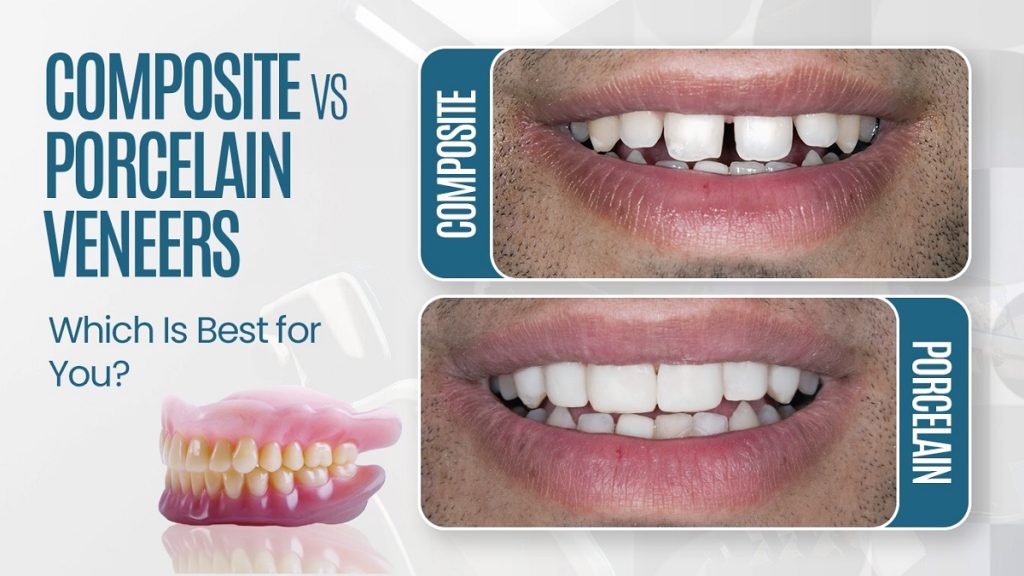Dental veneers have revolutionized cosmetic dentistry, offering a transformative solution for those seeking to enhance their smiles. These thin, custom-made shells are expertly designed to cover the front surface of teeth, providing remarkable improvements in colour, shape, size, and length. In today’s market, two primary options dominate: composite veneers and porcelain veneers. Each type presents unique advantages and considerations that deserve careful examination before making this important dental decision.
Understanding the Types of Veneers
The world of dental veneers encompasses two main categories: composite and porcelain. These distinct options differ not only in their material composition but also in their application processes, durability, and aesthetic outcomes. Understanding these differences is crucial for making an informed decision about your dental care.
Composite Veneers
Composite veneers represent an innovative blend of plastic and fine glass particles, creating a versatile composite resin material. Dental professionals can either sculpt this material directly onto the teeth or create precisely crafted pieces in a laboratory setting to achieve your desired aesthetic goals. This flexibility in application makes composite veneers a popular choice among many patients.
Pros of Composite Veneers:
-
Affordability
One of the most compelling advantages of composite veneers is their cost-effectiveness. These veneers provide a budget-friendly alternative to porcelain while still delivering noticeable improvements in dental aesthetics.
-
Quick Dental Procedure
The efficiency of composite veneer application is remarkable, often requiring just a single dental visit. This time-saving aspect makes them particularly attractive for individuals seeking rapid smile enhancement.
-
Reparability
Should damage occur, composite veneers offer the convenience of easy repairs. Unlike their porcelain counterparts, minor chips or cracks can typically be addressed through simple repair procedures rather than complete replacement.
Cons of Composite Veneers:
-
Durability
The composite resin material, while sturdy, doesn’t match the longevity of porcelain. Over time, these veneers may show signs of wear and become more susceptible to staining.
-
Aesthetics
Though composite veneers provide a natural appearance, they may not achieve the same depth of translucence and lustrous quality characteristic of porcelain veneers.
-
Lifespan
The typical 5-7-year lifespan of composite veneers falls short of porcelain’s durability, potentially necessitating more frequent replacements.
Porcelain Veneers
Porcelain veneers represent the pinnacle of dental aesthetics, crafted from premium ceramic materials that masterfully replicate the natural appearance of teeth. These custom-created shells are meticulously fabricated in specialized dental laboratories and secured to the teeth using advanced adhesive technologies.
Benefits of Porcelain Veneers:
-
Natural Appearance
The exceptional translucent properties of porcelain create an uncannily natural look, closely mimicking the light-reflecting characteristics of natural tooth enamel.
-
Durability
With proper care, porcelain veneers demonstrate remarkable longevity, often lasting 10-15 years or more while maintaining their resistance to staining.
-
Minimal Maintenance
Beyond regular oral hygiene practices, porcelain veneers require little additional maintenance, making them a convenient long-term solution.
Drawbacks of Porcelain Veneers:
-
Cost
Porcelain veneers’ superior quality and craftsmanship command a higher price point, which may place them beyond some patients’ budgets.
-
Lengthy Process
Creating and applying porcelain veneers typically requires multiple dental visits, as the custom fabrication process demands precision and time.
-
Irreversibility
The procedure often necessitates removing a thin layer of natural tooth enamel, making this a permanent commitment to dental veneers.
The Dental Procedure for Veneers
The veneer application process follows a systematic approach, regardless of the chosen material:
- Consultation and Planning – Initial discussions with your dentist focus on evaluating your dental condition, understanding your aesthetic goals, and determining the most suitable veneer type.
- Preparation – The preparation phase varies between types, with porcelain veneers requiring careful enamel reduction while composite veneers might need minimal or no preparation.
- Impression Taking – Creating precise impressions is crucial, particularly for porcelain veneers, as these serve as the blueprint for laboratory fabrication.
- Bonding – The final step involves securing the veneers using specialized adhesive materials, with composite veneers being shaped and polished directly on the teeth.
Choosing Between Composite and Porcelain Veneers
-
Affordability of Composite Veneers
The economic advantage of composite veneers makes them attractive for those seeking smile enhancement within a modest budget. This cost-effectiveness doesn’t compromise the quality of results; as composite veneers still deliver significant aesthetic improvements.
-
Aesthetic Goals
Porcelain veneers often emerge as the preferred choice for those pursuing the ultimate in natural-looking results. Their superior translucence and durability make them ideal for achieving and maintaining a flawless smile appearance.
-
Longevity and Durability
Porcelain veneers demonstrate superior resilience against wear and staining when considering long-term value. However, composite veneers serve admirably as a shorter-term or transitional solution.
-
Maintenance and Repairs
The repairability of composite veneers offers practical advantages, allowing for quick fixes of chips or cracks through reshaping and polishing. Porcelain veneer damage typically requires complete replacement, though such occurrences are rare due to their durability.
The Final Decision
The choice between composite and porcelain veneers ultimately rests on a careful evaluation of your personal needs, financial resources, and long-term dental goals. Professional consultation with an experienced dentist proves invaluable in making this decision, as they can provide targeted recommendations based on your unique dental situation and lifestyle factors.
A thorough understanding of each veneer type’s characteristics enables you to make a choice that aligns with your expectations for both immediate results and long-term satisfaction. Whether you select the economic benefits of composite veneers or invest in the lasting elegance of porcelain, both options offer the transformative potential for achieving a more confident and radiant smile.
If you are looking forward to having a composite of porcelain veneers, visit us at Bayswater Dentist. At Bayswater Dentist, we combine years of cosmetic dentistry expertise with state-of-the-art technology to deliver exceptional veneer results. Our experienced team specializes in both composite and porcelain veneers, offering personalized consultations to help you make the best choice for your smile. Our track record of satisfied patients and commitment to using only the highest quality materials ensures that you’ll receive the best possible care for your smile transformation.

